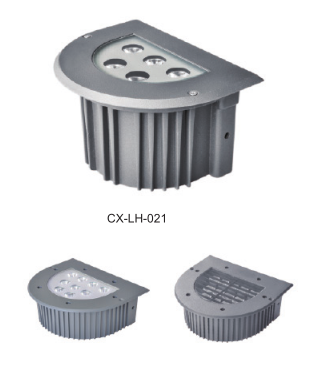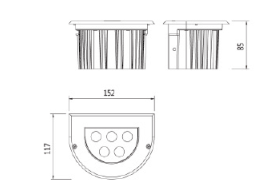At present, the domestic LED package mainly adopts the traditional potting process, and directly applies fluorescent glue on the surface of the chip. This way, the spherical crown-shaped phosphor coating has obvious structural defects (inconsistent thickness from the center to the edge). Moreover, regardless of manual or machine operation, the phosphor layer of the same batch of LED light source will have a certain difference in shape, it is difficult to control uniformity and consistency, and will bring a large chromaticity difference between LED light sources; Due to the unevenness of the microscopic surface of the fluorescent rubber coating, the difference between the individuals is large. When the light is incident, unevenness of the white light color is formed, resulting in uneven yellow spots or partial blue spots.
The difference between the chip-level light source and the traditional package is that the traditional package is a single method of powdering and sealing to complete the packaging process, and the chip-level light source adopts spraying, molding and other processes to complete the related packaging process, and the single-step process simultaneously completes multiple packages. The packaging of the light source can overcome the defects of light color unevenness and different light distribution caused by the above single dispensing process. Moreover, under the same area, the package density of the chip-scale light source is increased by 16 times, and the final package volume is 80% smaller than the conventional one, and the luminaire design space is larger.
Taking the manufacturing process of Jingke Electronic Easy Star series LED light source products as an example, the chip-level white LED light source without gold wire generally has to go through five production steps, as shown in the figure.

Step 1: Flip the bonding
Flip-bonding is a process of combining a blue LED chip with a ceramic substrate. The principle of the combination is ultrasonic thermo-compression bonding, that is, the LED chip is pressure-bonded to the corresponding electrode of the ceramic substrate while ultrasonic heating is applied. In order to ensure a good bond between the chip and the substrate, it is necessary to provide a metal bump solder ball on the chip or the substrate in advance, and it is necessary to ensure that the ultrasonic soldering temperature reaches 160 ° C. The chip and substrate combined by flip-chip bonding have an electrode contact area of ​​about 60% of the chip area, and the chip thrust is more than 2000g. The stable combination will provide a good channel for conduction and heat conduction, thereby ensuring high current use. Stable and long-term work is reliable.
Step 2: Spray phosphor
This is the first key technology in chip-scale packaging. First, a steel mesh is placed on a ceramic substrate with a chip. The hole on the steel mesh corresponds to the position of the chip on the ceramic substrate, and then pre-distributed using a professional phosphor sprayer. A good fluorescent glue is sprayed onto the ceramic substrate on which the steel mesh is placed, and after the spraying, the steel mesh is taken away to prepare a uniform and uniform phosphor coating on the chip of the entire ceramic substrate. In order to ensure the uniformity of the color of the white light source on the entire ceramic substrate, the chip needs to be sorted before the flip-chip bonding, and the phosphor layer can be more uniform by spraying multiple times during the spraying.
Step 3: Molding the lens
This is the second key technology of the chip scale package. The whole ceramic substrate coated with fluorescent glue is sent into the cavity of the Moldin g (molding) machine, and the packaged silica gel is injected into the mold to heat the mold. After the silica gel is cured, the lens Moklin g of the entire ceramic substrate can be completed after demolding. Precision molds and a stable demolding process are key to ensuring a consistent silicone lens.
Step 4: Cutting
After the LED package on the entire ceramic substrate is completed, the cutting separation is required for the next test. The cutting process of ceramic sheets mainly includes blade cutting and laser cutting. The process is relatively simple, and the focus is on avoiding damage to the silicone lens.
Step 5: Test and pack
The specifications that need to be tested and classified mainly include the following, operating voltage, luminous flux, color temperature, and color rendering index. Products of the same specification are packaged together in a tape and reel, compatible with subsequent automated placement processes.
Led Underground Lamp is a new type of buried decoration lamp with high brightness LED as the light source and LED constant current drive as the driving mode.Widely used in square, park, leisure places, such as outdoor lighting, outdoor as well as park, square, garden greening, lawn, flower beds, pedestrian street, waterfalls, fountains, water etc illumination, add luster for life.

Product size

Technical parameters
|
Main material |
High - pressure cast aluminum, 92% high - light steel screen printing glass |
The light colored temperature |
Red/Green/Yellow/Amber/Vermilion/Acid blue/3000K/4000K/5000K/6000K
|
|
Surface treatment |
UV Polyester powder coating |
Light distribution device |
Reflector lamp cup series:6° Optical lens series:8°/15°/25°/45°/10×30°/10×60°/20×40° |
|
The light body color |
Dark grey |
Working voltage |
DC24V |
|
Safeguard procedures |
Silica gel ring compacted waterproof |
way to install |
Embedded part |
|
Average lifetime |
350mA20000hours,500mA15000hours |
rated power |
/ |
|
Control mode |
/ |
Level of protection |
IP65 |
|
operating ambient temperature |
-25℃~50℃ |
Working environment humidity |
10%~90% |
Led Underground Lamp ,Led Underground Headlamp,Led Cap Lamp Underground Mining,Underground Led Cap Lamps
Jiangsu chengxu Electric Group Co., Ltd , https://www.chengxulighting.com